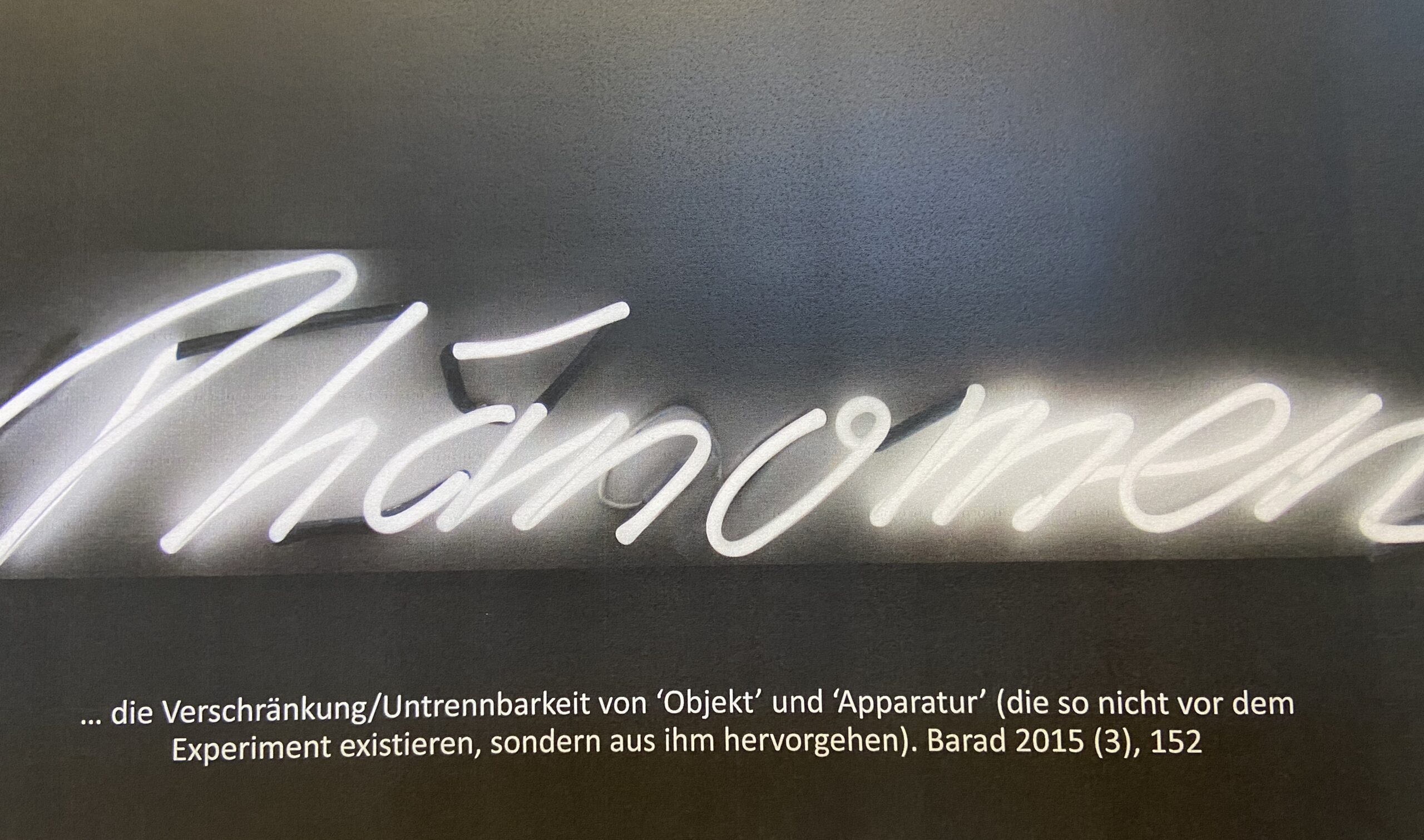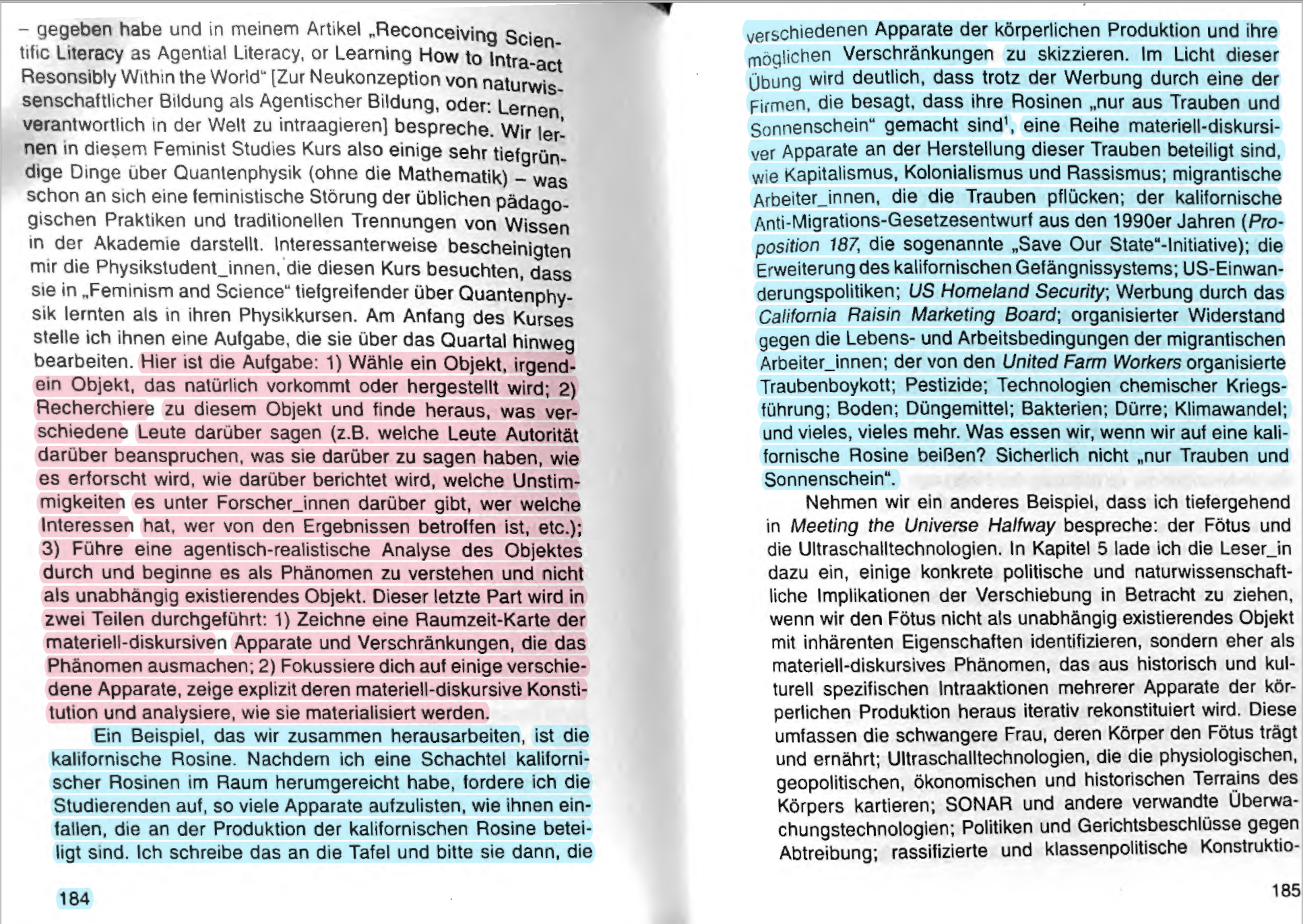“How can the possibility of the queerness of one of the most pervasive of all critters – atoms – be entertained? These “ultraqueer” critters with their quantum quotidian qualities queer queerness itself in their radically deconstructive ways of being. The aim is to show that all sorts of seeming impossibilities are indeed possible, including the queerness of causality, matter, space, and time.”
Barad, Karen. 2012. “Nature’s Queer Performativity.” Kvindor, Kön & Forskning 1–2: 25–53.
An approximate definition
In 1996 Karen Barad describes in “Meeting the Universe Half-way” the concept of Agential Realism by referring to two different approaches in natural science, specifically in quantum physics: she positions Isaac Newton’s atomist world view against Niels Bohr’s principle of correspondence. While Newton’s metaphysical naturalism assumes that matter has such limited agency that it can be ignored within experimental settings, Bohr suggests the opposite by saying that the agency of each individual instance of an observation setting has to be considered. Other than Newton, with this claim of agency, Bohr also overcomes the, in the traditional natural sciences predominant, separation between subject and object towards in inter-dependent co-creation, an intra-action that lets “objects” emerge as part of a phenomenon, rather than representing the preexisting. According to Bohr, scientific observation is always a form of mediated nature, or, as Barad would call it: agential realism.

Quantum physics as an argument for agential realism
In quantum physics, matter can be both particle and wave at the same time, depending on how it is measured.
Classical: Isaac Newton`s metaphysical naturalism: independence and separation of object and subject -> Result of measurement is independent of observation.
Alternative: Nils Bohr`s philosophy-physics: no independent observation authority. Observation is a form of mediated nature, the agency of each individual actor, human and non-human, and its conditions must be considered.
But it also means that the media of observation (production) play a role, have “agencies of observation” and influence the constructions of reality. Barad considers this as an argument for new, alternative forms of thinking about the world. She suggests new perspectives on concepts such as space, time, matter, causality, agency, subjectivity, and objectivity and understands agential realism as a new way of, not only reflecting on, but also doing science.
Definitions of agential realism
1. Agential realism founds and situates knowledge claims in local experiences: objectivity is literally embodied;
2. Agential realism privileges neither the material nor the cultural: the apparatus of physical production is material-cultural, and so is agent reality;
3. Agential realism requires investigation and boundary-making and critical reflexivity; and
4. Agential realism emphasizes the need for an ethics of knowledge.
Agential realism as a method
With “the ontological inseparability of intra-acting agencies” as the key aspect, the concept of agential realism exceeds quantum physics. Barad “contributes to feminist reinterpretations of objectivity as agential responsibility, and of agency as embodied, worldly, and intra-active” (Rouse: 2004). Agential realism, is at once a new epistemology, ontology, and ethics and, thus, can be applied as a tool for analysis and thinking. It works as a useful concept for understanding agential relations within the natural sciences, as well as the social sciences, and humanities. Particularly the agent-realistic analysis as suggested below turns it into an analytical method that may be worth testing out in transdisciplinary projects.
Barad suggests an agent-realistic analysis as a method to approach phenomena as follows:

Ref.: Barad, Karen. 2015. Verschränkungen. Vol. 409. Berlin: Merve Verlag. Internationaler Merve-Diskurs. p. 184-185.
String figures as an example

Photograph by Donna Haraway.
https://blog.mtr.zhdk.ch/boundarywork/string-figures-speculative-fabulation/
The post on string figures refers to Donna Haraway`s concept of entanglement and inter-action, or with Barads words, intra-action. To play the game further, I would like to suggest to understand the concept of string figures as an example for agential realism.
The image of sting figures stresses the observation made by Haraway, that everything is connected to something, yet not with everything. This argument against relativism is what Barad understands as material-discursive. Every produced meaning is the consequence of a particular material intra-action that, in its production also excludes other possibilities. The emerging (string figure) object is dependent on the agents engaged with it and the result changes with them…
Further readings and references:
Karen Barad. 1996. Meeting the universe halfway: Realism and social constructivism without contradiction. In Feminism, science and the philosophy of science, ed. Jack
Nelson and Lynn Hankinson Nelson. Dordrecht: Kluwer.
Barad, Karen. 2007. Meeting the Universe Halfway: Quantum Physics and the Entanglement of Matter and Meaning. Durham: Duke University Press.
Barad, Karen. 2012. “Nature ’ s Queer Performativity.” Kvindor, Kön & Forskning 1–2: 25–53.
Karen Barad. 2015. Verschränkungen. Vol. 409. Berlin: Merve Verlag. Internationaler Merve-Diskurs.
Lemke, Thomas. 2015. “New Materialisms: Foucault and the ‘Government of Things.’” Theory, Culture & Society 32 (4): 3–25.
Rouse, Joseph. 2004. “Barad ’ s Feminist Naturalism Barad ’ s Feminist Naturalism” 19 (1): 142–61.